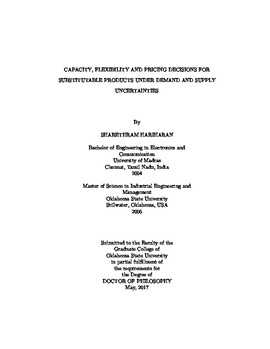| dc.contributor.advisor | Liu, Tieming | |
| dc.contributor.author | Hariharan, Sharethram | |
| dc.date.accessioned | 2018-06-25T13:38:22Z | |
| dc.date.available | 2018-06-25T13:38:22Z | |
| dc.date.issued | 2017-05 | |
| dc.identifier.uri | https://hdl.handle.net/11244/300243 | |
| dc.description.abstract | We study the resource investment and pricing decisions for a profit-maximizing firm producing two substitutable products with partially flexible resources facing three types of uncertainties separately: demand uncertainties, capacity uncertainties and supply disruptions. The resources are partially flexible indicating efficiency losses when a resource designed for one type of product is used to produce another type (i.e., cross-production): The Shrinking Capacity model explicitly captures the fact that fewer units of products will be produced under cross-production. If the degree of flexibility is zero, the firm cannot cross-produce. The Additional Cost model captures the unit increase in production cost due to cross-production. Cross-production is possible even when degree of flexibility is zero but incurs a higher production cost. | |
| dc.description.abstract | We find that product substitutability, type and severity of uncertainties as well as type of efficiency loss play a key role in deciding the optimal investment strategies. When facing low or moderate demand and capacity uncertainties, flexibility is not required under both models. However, if demand or capacity uncertainties is high, a moderate degree of flexibility maybe beneficial under shrinking capacity if the products are highly differentiated and demands are negatively correlated. Shrinking capacity also suggests a moderate degree of flexibility that decreases with product substitutability under high capacity uncertainties. As the degree of supply disruptions increases flexibility is extremely valuable under any demand intercept correlation even for highly substitutable products. The additional cost model suggests investing in full flexibility only if the unit cost of dedicated capacities were higher, demands are negatively correlated and firm is forced to clear capacities. While literature has shown flexibility to be less beneficial as resource investments become less reliable, our research shows that this is not always true. It also explains why completely flexible resources are still rare in industrial practice, although it has been highly advocated in academia. | |
| dc.format | application/pdf | |
| dc.language | en_US | |
| dc.rights | Copyright is held by the author who has granted the Oklahoma State University Library the non-exclusive right to share this material in its institutional repository. Contact Digital Library Services at lib-dls@okstate.edu or 405-744-9161 for the permission policy on the use, reproduction or distribution of this material. | |
| dc.title | Capacity, flexibility and pricing decisions for substitutable products under demand and supply uncertainties | |
| dc.contributor.committeeMember | Kamath, Manjunath | |
| dc.contributor.committeeMember | Sharda, Ramesh | |
| dc.contributor.committeeMember | Ingalls, Ricki | |
| dc.contributor.committeeMember | Balasundaram, Balabhaskar | |
| osu.filename | Hariharan_okstate_0664D_15010.pdf | |
| osu.accesstype | Open Access | |
| dc.type.genre | Dissertation | |
| dc.type.material | Text | |
| thesis.degree.discipline | Industrial Engineering and Management | |
| thesis.degree.grantor | Oklahoma State University | |
